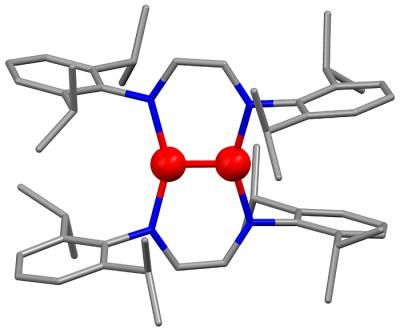UD researchers set new chemical world record
Advertisement
Chemists from the University of Delaware, in collaboration with a colleague at the University of Wisconsin, have set a new world record for the shortest chemical bond ever recorded between two metals, in this case, two atoms of chromium.

This graphic depicts the bond between two atoms of chromium that has set a new record for the shortest chemical bond ever found between two metals.
Klaus Theopold
The distance? A minuscule 1.803 Ångstroms, which is on the order of a billionth of the thickness of a human hair. The chemists weren't driven by the Guinness Book of World Records or even a friendly bet. As is often the case in science, they discovered the molecule, which has a quintuple (i.e., fivefold) bond, quite by accident.
"Sometimes things like this just happen," said Klaus Theopold, professor and chairperson of the UD Department of Chemistry and Biochemistry.
Theopold and Kevin Kreisel, who graduated with his doctorate from UD in August and is now a postdoctoral researcher at the University of Wisconsin, made the finding, working with research associate Glenn Yap and postdoctoral fellow Olga Dmitrenko, both from UD, and Clark Landis, a colleague from the University of Wisconsin. The research was reported in the Journal of the American Chemical Society.
Theopold has been researching the chemistry of chromium for a long time. The metal is an important industrial catalyst for making plastics such as polyethylene.
"We discovered this interesting looking molecule and realized that it had an extremely short distance between the metal atoms," Theopold said.
Using an analytical technique called X-ray diffraction, the scientists were able to look directly at the atomic structure of the new molecule and measure the distance between the chromium atoms. A rule-of-thumb in chemistry, Theopold said, is that bond length and bond strength go together, so it's likely that the metal-metal bond is a strong one, although Theopold said no one knows for sure.
Most read news
Topics
Organizations
Other news from the department science

Get the chemical industry in your inbox
By submitting this form you agree that LUMITOS AG will send you the newsletter(s) selected above by email. Your data will not be passed on to third parties. Your data will be stored and processed in accordance with our data protection regulations. LUMITOS may contact you by email for the purpose of advertising or market and opinion surveys. You can revoke your consent at any time without giving reasons to LUMITOS AG, Ernst-Augustin-Str. 2, 12489 Berlin, Germany or by e-mail at revoke@lumitos.com with effect for the future. In addition, each email contains a link to unsubscribe from the corresponding newsletter.





























































